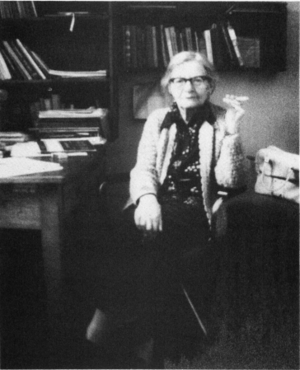Liliana Lubińska facts for kids
Liliana Lubińska (born October 14, 1904 – died November 19, 1990) was a brilliant Polish brain scientist. She is famous for her work on the peripheral nervous system, which is like the body's communication network outside the brain and spinal cord. She also discovered something important called axoplasmic transport, which is how nerve cells move materials. With her husband, Jerzy Konorski, she helped start the Department of Neurophysiology at the Nencki Institution in 1946.
Contents
Early Life and Learning
Liliana Lubińska was born in Łódź, Poland, in 1904. She later married Jerzy Konorski, who was also a brain scientist. In 1923, Liliana began studying biology at the University of Warsaw.
Studying in Paris
Just one year later, she moved to Paris, France. She continued her studies in biological sciences at the University of Paris, Sorbonne. In 1927, she earned her first degree in biological chemistry and physiology.
Earning Her Doctorate
Liliana then worked towards her doctorate degree, which she received in 1932. During this time, she worked in a lab studying how nerves respond to signals. Her main research for her doctorate was about how reflexes work. She even won an award for her excellent work from the Academy of Paris.
Her Scientific Career and Discoveries
After finishing her studies in Paris, Liliana Lubińska started her own research. She looked at how different things affected how easily nerves and muscles could be excited. She also joined experiments on how animals learn new behaviors at the Nencki Institute of Experimental Biology in Warsaw.
Challenges During Wartime
When World War II started in 1939, her institute was destroyed. Liliana and her husband, Jerzy, had to leave Warsaw. They tried to go to England but couldn't. They ended up in Białystok, Poland. When the war spread, they had to move again, this time to the Caucasus region.
Research During the War
From 1940 to 1945, they worked together in Georgia. They studied how damaged nerves could grow back, which is called nerve regeneration. This was very important work, even during difficult times.
Discovering Axoplasmic Transport
After the war, Lubińska continued her research on the peripheral nervous system. From 1945 until she retired in 1982, she studied how nerves are built and how they work. She especially focused on axoplasmic transport. She showed that materials can move in both directions along nerve fibers. This was a big discovery!
Contributions to Brain Science
Liliana also worked with other famous scientists. They helped show that a part of the brain called the brain stem helps us be aware and control our body's position. This work helped scientists understand more about how our brains control being awake and even dreaming. Liliana Lubińska published about 80 scientific papers. She was known as a leader in her field.
Awards and Recognitions
Liliana Lubińska received many honors for her important work:
- She was on the editorial board for the science journal Neuroscience from 1976 to 1990.
- She became a foreign member of the German Academy of Natural Scientists Leopoldina.
- She was an honorary member of the International Brain Research Organization.
- She received the Solange Coemme prize from the Académie Nationale de Médecine.
- She was an honorary member of the Polish Physiological Society.


